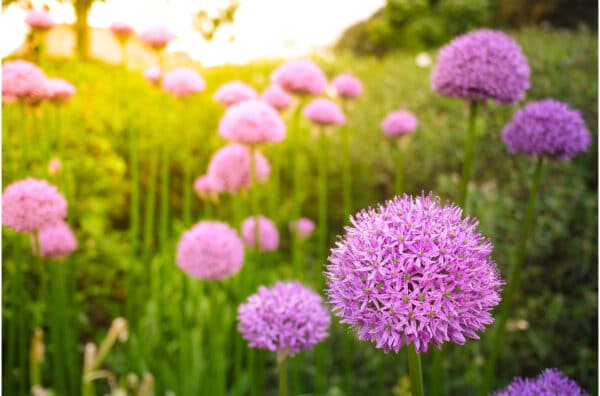Fall Planting For Spring Flowers
Fall is a great time to take stock of your gardens to determine what worked well and what improvements can be made. It’s always a good idea to record your successes and any gardening challenges in a journal to help you prepare for next season.
Whether you’re considering changing up the look of your gardens or you’ve discovered some plants require alternate growing conditions (more shade or full sun, for example), now is a great time to transplant perennials and divide plants that have become overgrown. When making your plans, be sure to consider your frost hardiness zone; you’ll want to transplant 6 weeks before a hard frost to give plants enough time to adjust to a new location.
Transplant Perennials in Fall
It’s always a good idea to add organic matter to your garden beds before transplanting. Nature’s Magic is the perfect liquid soil conditioner, adding concentrated organic matter, molasses, and humic & fulvic acids to the soil in seconds, without the hassle of heavy (often smelly) compost.
Dividing Plants
Overcrowded plants will show signs that they need to be divided. They may bloom less, have smaller blooms, or stems may grow so tall that they need to be staked to keep from falling over. Crowded plants compete for resources, and they’re more at risk for plant diseases.
To divide a plant, first dig up the entire perennial. Then brush or shake off as much dirt as you can from the roots. Separate the plant into groups of 3 to 5 shoots to ensure they’ll recover when transplanted. Most perennials can be easily pulled apart with your hands, but you can use a spade to cut through any tough roots. You won’t cause any lasting damage to the plant by separating them. Keep the plants shaded and moist until you’re ready to transplant – if you can, wait for a cool, cloudy day to keep them from drying out.
Planting
Dig your hole 1 – 2 inches deeper and 6 – 9 inches wider than the new root ball. Gently break up the soil around the roots of the plant to loosen them up before placing it into the new spot. Cover the roots loosely with soil and water deeply. Add soil as needed to fill in the hole. Spread mulch over the soil to discourage weeds, retain moisture, and insulate against the snow. Water deeply once a week until the first frost to encourage deep rooting.
Fall Planting for Spring Flowers
Fall is also a prime time to start thinking about spring flowers. If you’re like us and live in an area where winter lasts well beyond its welcome, you’ll be happy you took the time now to plant spring-flowering bulbs. Seeing those first few blooms peeking out always lifts our spirits!
Why Plant Bulbs in Fall?
Autumn is the perfect time to get your spring bulbs in because the soil is still warm and allows them to develop their root system. Most spring-flowering bulbs actually need a period of colder weather to trigger their spring blooms.
Choose where to plant
You can plant bulbs just about anywhere in your garden, as long as the soil drains well. Bulbs need a spot with good drainage or they may rot. Bulbs like sun, and in many areas, the leaves on trees aren’t out yet in spring, so many areas of your garden could work great for spring bulbs.
Prepare your soil
Work a few inches of compost or organic matter into the soil before planting for nutrients and drainage, especially if you have heavy clay soils. Aerify PLUS is the Ultimate Soil Conditioner. It loosens compacted and clay soils, and adds organic ingredients that can help create humus, improving soil structure and soil bioactivity. Additionally, Aerify PLUS improves the health of all plants by providing an assortment of trace elements and micro-nutrients not found in common fertilizers.
Plant
Depending on the bulb, follow the recommendation on the label for planting depth. As a general rule, plant big bulbs about 8″ deep and small bulbs about 5″ deep. Set the bulb in the hole pointy side up or with the roots down. If you can’t figure out the top from the bottom, plant the bulb on its side. In most cases, the flower will still find its way up. You may want to plant extra bulbs in case they don’t bloom or critters get at them. Be sure to mark where you plant them so you don’t disturb them later.
Fertilize
After planting, apply fertilizer that’s fairly low in nitrogen, such as organic liquid fertilizer, Plant Food Hero (3-2-2) to stimulate earthworm activity, increase nutrient absorption, add organic matter to soil, and improve plant resistance to disease, insects, and weather stress. Mix 1-2 oz per gallon of water and drench the soil around the bulb.
Water
Water bulbs deeply after planting – the water will need to soak in as deep as you planted in order to benefit the bulb. This will help settle the soil in the planting bed plus provide needed moisture for the bulbs to start rooting. Water every 2 weeks with Plant Food Hero until the ground freezes. Be careful not to overwater, which can lead to bulb rot. Gardeners in southern locations can water again in late December or early January if it’s been a dry winter.
Mulch
Remember to save your last grass clippings and fall leaves to shred into beneficial mulch! Applying mulch to the planting area will help to keep the weeds down, hold in moisture, and avoid any ground heaving from wintertime thawing and freezing.
Best Bulbs to Plant in Fall
The following bulbs do best when planted in cooler weather, when evening temperatures drop to 40-50 degrees:
Allium
Bluebells
Crocus
Daffodils
Hyacinths
Iris
Lilies
Narcissus
Snowdrops
Tulips
And, – garlic! If you’ve never tried it before, consider planting garlic this fall. Garlic is one of the easiest edible plants you can grow, and it’s so much more flavorful when it’s fresh. Check out our blog for tips on how to grow amazing garlic!
At Nature’s Lawn & Garden, we’re always here to help! As always, if you have any questions about your lawn, garden, or our products, feel free to contact us!



